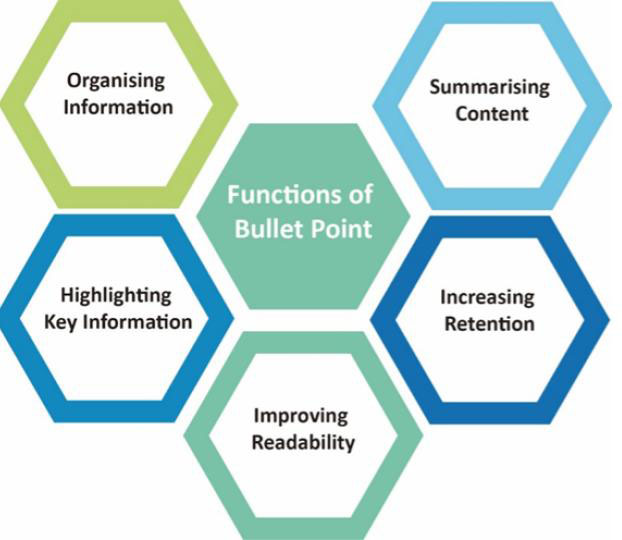Abstract
As we currently live in an era where we are bombarded by information, it is expected to be more vigorous in future. The most effective way to deliver a message to audiences or readers (most of whom are amateurs) is to do so in a unique way. This is a significant concern for designers and information architects. As such, there is a need to explore new forms of information organisation that can create stronger impacts and a more humanistic approach for readers. This approach will enquire a writer to attract a readers’ attention when they were reading information and publications. The writer must emphasise key concepts during information construction, which can be achieved using bullet points. Bullet points assist document creators (writers and designers) to direct the reading path and understanding of readers. Readers will be able to accept key concepts easier if they can understand them effectively. Thus, the bullet points approach serves as an important tool for enhancing information processing.
In the establishment of information hierarchy, bullet points have been developed into different styles and visual elements that include, but are not limited to, points, lines, and shapes. Will certain symbols or wingdings communicate better than just dots? Will their style affect the credibility of the information and influence the information categorisation? Understanding these questions will assist in raising the awareness of designers and writers regarding information hierarchy through document communication.
However, there is a lack of sufficient studies to realise the principles for using bullet points. There is no standard bullet point for specific information processing; incorrectly adopted bullet point styles can affect information processing and thus, influence the authority of the document. Hence, this study investigates the nature of the bullet point system and how its application can construct an information hierarchy, as well as its use in terms of affecting the organisation and typesetting structure of documents. It provides the fundamental knowledge ground for further supporting the investigation of the influence of visual elements (including typographic elements) on the emotional attachment and psychological logic of readers and their way of information processing.
Aims
This research project aims to explore the theoretical development of the bullet points system and the application of bullet points in constructing the information hierarchy. The research scope includes revealing the usages of bullet points in the typesetting organisation for the publication design for visual design studies. Various bullet point examples will be collected and analysed from different sources of literature and documents researched through data collection and content analysis, to realise how they could be documented. This study provides an excellent opportunity to let students, designers, and the general public understand that simple visual elements commonly used in typography (e.g., point, line, etc.) would influence the information processing of readers (i.e., message receivers). They are formulated as visual aids to help audiences understand and process the information being presented. The shapes, sizes, and presentation approaches of these visual aids of bullet points system could affect the credibility of publication design and visual design for communication through the structure of the information hierarchy (Armel & Rushton, 2009; Woloszyn, Rodrigues & Gonçalves, 2020) and how this could affect the audience’s emotion for perceiving the information.
Objectives
● To explore the theoretical development of the bullet point system and the application of bullet points in constructing the information hierarchy.
● To investigate the usage of the bullet points system in the typesetting organisation for the publication design for visual design studies.
● To collect and analyse different literature sources and documents through data collection and content analysis.
● To provide a good opportunity for students, designers, and the general public to understand the simple visual elements commonly used in typography (e.g., point, line and so forth) could also influence the information processing of readers (i.e., message receivers).
● To establish the structure of the information hierarchy principle that would affect the audience’s emotions when perceiving the information.



Deliverables
Types and Role of Bullet Points System in Reading.
HO, A. G. (forthcoming, July 2023). In: Amic G. Ho (eds) Human Factors in Communication of Design. AHFE (2023) International Conference. AHFE Open Access, vol ??. AHFE International, USA.
A Critical Overview of Studies on Eye Tracking and Visual Hierarchy.
HO, A. G. (forthcoming, July 2023). In: Hasan Ayaz (eds) Neuroergonomics and Cognitive Engineering. AHFE (2023) International Conference. AHFE Open Access, vol ??. AHFE International, USA.
Practical Application of Bullet Point Systems for Constructing an Information Hierarchy.
HO, A. G. (2020). In: Markopoulos E., Goonetilleke R., Ho A., Luximon Y. (eds) Advances in Creativity, Innovation, Entrepreneurship and Communication of Design. AHFE 2020. Advances in Intelligent Systems and Computing, vol 1218. Springer, Cham.
https://doi.org/10.1007/978-3-030-51626-0_32
Bullet Points: Applying Emotional Symbols in Information Management.
HO, A. G. (2019). In: HO, A. (eds) Advances in Human Factors in Communication of Design. AHFE 2019. Advances in Intelligent Systems and Computing, vol 974. Springer, Cham.
https://doi.org/10.1007/978-3-030-20500-3_4
Funded Sources
HKMU R&D Fund
Project Reference No.
RD/2022/1.21
Period
2021-2022
Funded amount
HKD 180,030
Principal Investigator
Dr Amic G. HO
Research Assistant
Ms Ruth CHAU P. W.

